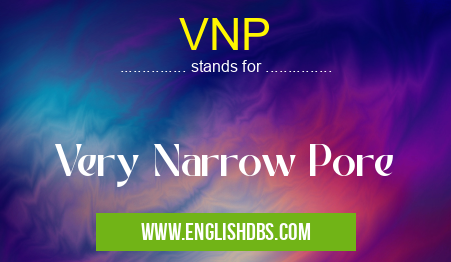What does VNP mean in UNCLASSIFIED
VNP stands for Very Narrow Pore. It refers to a type of membrane with extremely small pores that allow only specific molecules or ions to pass through. VNPs are commonly used in filtration, purification, and separation processes.

VNP meaning in Unclassified in Miscellaneous
VNP mostly used in an acronym Unclassified in Category Miscellaneous that means Very Narrow Pore
Shorthand: VNP,
Full Form: Very Narrow Pore
For more information of "Very Narrow Pore", see the section below.
Characteristics of VNPs
- Pore Size: VNPs have pore diameters typically ranging from 0.1 to 2 nanometers (nm).
- Molecular Selectivity: The small pore size of VNPs allows them to selectively allow or block molecules based on their size, charge, and shape.
- High Rejection: VNPs effectively reject larger molecules and particles, resulting in high purity of the filtrate.
- Low Flux: The small pore size also limits the flow rate of the filtrate, resulting in lower flux compared to larger-pore membranes.
Applications of VNPs
- Water Purification: VNPs are used in water filtration systems to remove contaminants such as bacteria, viruses, and heavy metals.
- Dialysis and Hemofiltration: VNPs are used in medical devices to remove waste products and toxins from the blood.
- Food and Beverage Processing: VNPs are used to clarify and purify juices, wines, and other beverages.
- Pharmaceutical Production: VNPs are used to purify and concentrate active pharmaceutical ingredients.
- Biotechnology: VNPs are used in research and development for protein purification and cell separation.
Essential Questions and Answers on Very Narrow Pore in "MISCELLANEOUS»UNFILED"
What is a Very Narrow Pore (VNP)?
A Very Narrow Pore (VNP) is a membrane with pores that are less than 2 nanometers in diameter. VNPs are used in various applications, including water purification, gas separation, and drug delivery.
How are VNPs made?
VNPs are typically made using a process called track-etching. In this process, a polymer film is irradiated with a beam of high-energy particles, creating a pattern of tracks. The film is then etched with a chemical solvent, which dissolves the polymer along the tracks, leaving behind a membrane with VNPs.
What are the advantages of using VNPs?
VNPs offer several advantages over other types of membranes. They have a high rejection rate for contaminants, they are resistant to fouling, and they can be operated at high pressures. Additionally, VNPs can be tailored to have specific properties, such as pore size, porosity, and surface chemistry.
What are the applications of VNPs?
VNPs are used in a wide variety of applications, including:
- Water purification: VNPs can be used to remove contaminants from water, such as bacteria, viruses, and heavy metals.
- Gas separation: VNPs can be used to separate gases, such as hydrogen from nitrogen or oxygen from nitrogen.
- Drug delivery: VNPs can be used to deliver drugs to specific parts of the body.
What are the challenges associated with using VNPs?
The main challenge associated with using VNPs is their low permeability. The small pore size of VNPs limits the flow of fluid through the membrane. This can be overcome by using a higher pressure or by using a membrane with a larger surface area.
Final Words: VNPs are highly selective membranes with extremely small pores that allow only certain molecules or ions to pass through. They are used in various applications, including water purification, dialysis, and pharmaceutical production, where high purity and removal of specific contaminants are essential. The unique properties of VNPs make them a valuable tool in filtration, separation, and purification processes.
VNP also stands for: |
|
| All stands for VNP |
